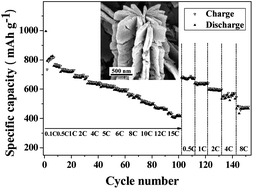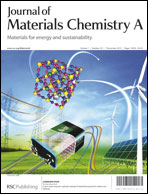Cosurfactant-mediated microemulsion to free-standing hierarchical CuO arrays on copper substrates as anodes for lithium-ion batteries†
Abstract
A cosurfactant-mediated microemulsion synthesis of free-standing CuO arrays with hierarchical micro-cog architectures on copper substrates has been successfully established. The CuO cog-array films directly employed as anode electrodes derive from thermal dehydration of Cu(OH)2 arrays grown from copper substrates in the presence of AOT–n-butanol–isooctane–water microemulsions. Introducing n-butanol as a cosurfactant into the ternary AOT–isooctane–water system increases the rigidity of the reverse micelles and it can be selectively adsorbed on particular crystal faces, leading to well-aligned arrays as well as enlarged aspect ratios with average heights of over 6 μm and diameters of 1–2 μm. This result sharply contrasts with the multilayer film of micro-cog particles with a shortened aspect ratio prepared in the absence of n-butanol. The CuO film electrodes of free-standing micro-cog-arrays exhibit excellent electrochemical performance, including a long cycling life (with capacity retention of 91.6% at 1 C over 300 cycles) and outstanding rate capability even at high current rates (about 466 and 418 mA h g−1 at high rates of 12 and 15 C) in lithium ion batteries.


 Please wait while we load your content...
Please wait while we load your content...